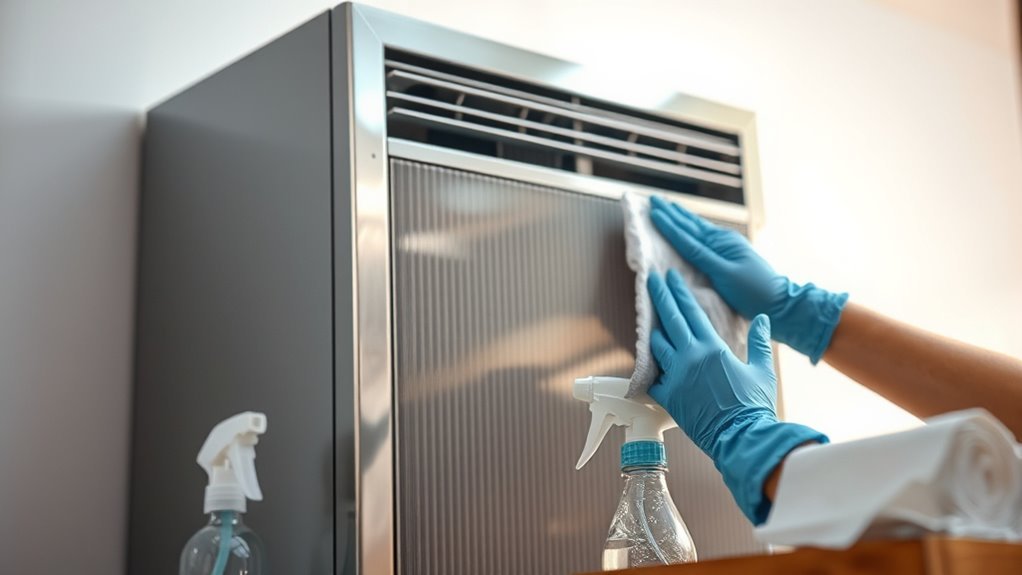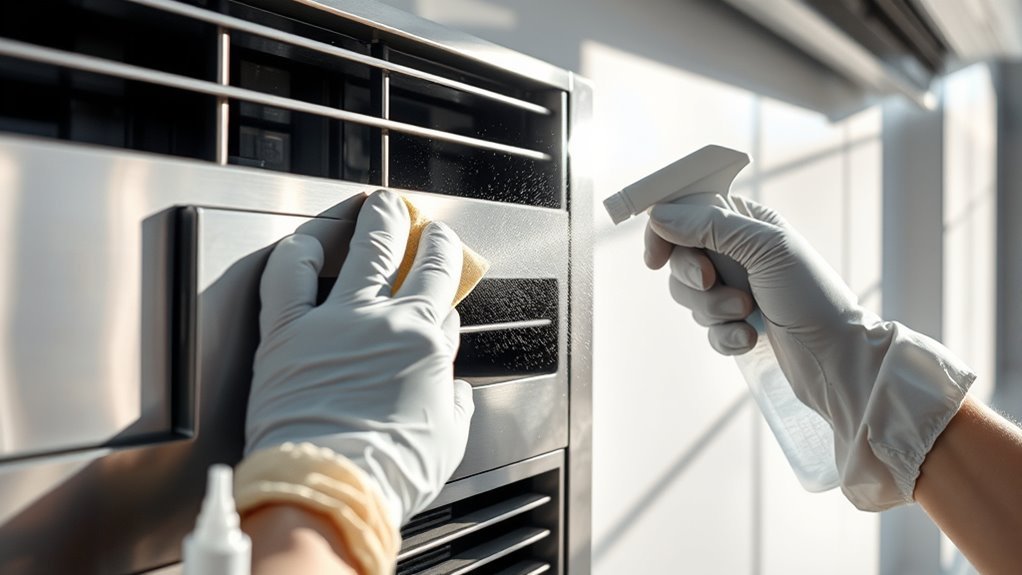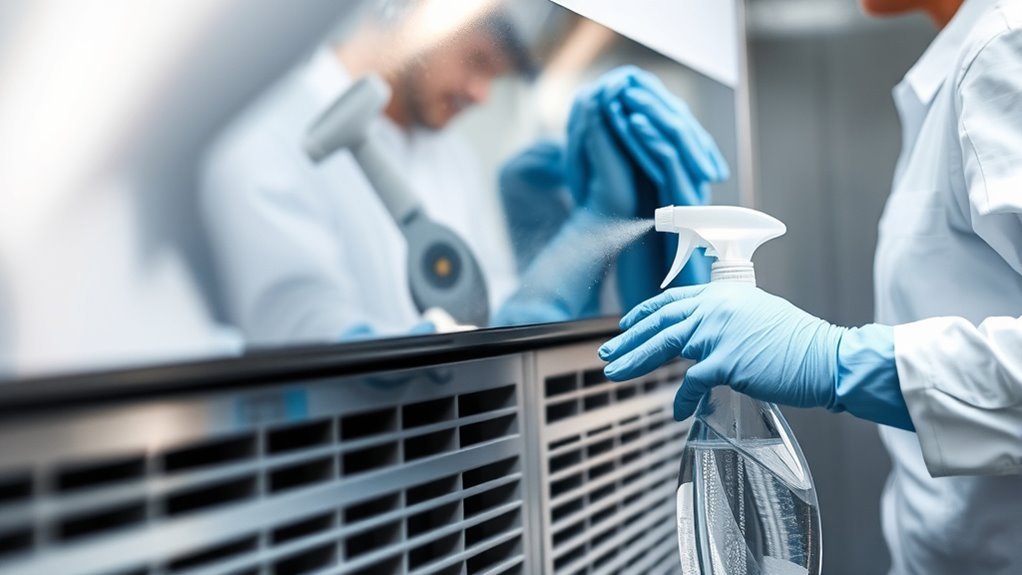Disinfecting High-Touch Areas in AC
To disinfect high-touch areas in your AC, first identify surfaces like control panels, thermostat buttons, and remote controls. Use an EPA-registered disinfectant compatible with your unit’s materials to avoid damage. Always power off the system before cleaning with a soft cloth to remove dust, then apply disinfectant, guaranteeing the recommended contact time. Maintain clean filters and vents to reduce contaminants. Following these precise steps guarantees effective microbial control and ideal air quality. Explore further methods to sustain efficient, germ-free operation.
Identifying High-Touch Surfaces in Air Conditioning Units

When maintaining air conditioning units, pinpointing high-touch surfaces is essential for effective disinfection. You need to focus on components frequently handled or adjusted, such as control panels, thermostat buttons, and remote controls. These areas accumulate contaminants due to repeated contact, increasing microbial presence. Additionally, door handles and vents, where users often interact or adjust airflow, qualify as high touch surfaces. Identifying these precise points guarantees targeted cleaning, reducing pathogen transmission risks without unnecessary chemical use on less critical parts. By methodically evaluating the air conditioning unit’s design and usage patterns, you can isolate the surfaces that demand your attention. This approach maximizes cleaning efficacy while preserving your freedom to operate and maintain your system safely and efficiently.
Choosing Safe and Effective Disinfectants
Although selecting disinfectants might seem straightforward, choosing ones that balance safety and effectiveness requires careful consideration. You’ll want to evaluate disinfectant effectiveness against common pathogens found on AC high-touch areas, ensuring thorough microbial control without damaging components or compromising indoor air quality. Consider these factors:
- Opt for natural alternatives when possible, as they reduce chemical exposure while maintaining antimicrobial properties.
- Verify the product’s EPA registration or equivalent certification, confirming validated disinfectant effectiveness.
- Assess compatibility with AC materials to prevent corrosion or degradation during use.
Step-by-Step Cleaning and Disinfection Process

To properly disinfect high-touch areas in your AC system, follow a systematic sequence of cleaning steps that guarantees maximum pathogen removal and prevents component damage. Begin by powering off the unit to confirm safety. Use a soft cloth dampened with a manufacturer-approved cleaner to remove dust and debris from control panels, knobs, and vents. Adhere strictly to your cleaning schedules to maintain consistent hygiene. Next, apply recommended disinfection techniques, such as using EPA-registered disinfectants, confirming full surface coverage without oversaturation. Allow the disinfectant to dwell for the specified contact time to inactivate microbes effectively. Finally, wipe surfaces dry with a clean cloth to prevent moisture buildup that could harm components. Regularly documenting this process within your cleaning schedules confirms ongoing system efficacy and freedom from contamination.
Tips for Maintaining Clean Filters and Vents
Because clean filters and vents are essential for ideal airflow and system efficiency, you should establish a routine inspection and maintenance schedule. For effective filter maintenance and vent cleaning, adhere to these tips:
- Check filters monthly; replace or clean them as specified by the manufacturer to prevent airflow obstruction and maintain air quality.
- Vacuum vents regularly to remove dust and debris buildup, ensuring unobstructed ventilation and reducing strain on your AC system.
- Inspect vent covers and ducts periodically for damage or blockages, addressing any issues immediately to sustain peak performance.
Preventative Measures to Reduce Germ Buildup

When you regularly disinfect high-touch areas in your AC system, you greatly reduce the risk of germ buildup. To further minimize germ transmission, establish a strict cleaning frequency based on usage intensity and environmental factors. Prioritize surfaces like control panels, vents, and door handles, which are frequent contact points. Use EPA-approved disinfectants compatible with your AC materials to avoid damage while ensuring efficacy. Implementing scheduled maintenance checks allows you to identify and address contamination early. Additionally, consider installing antimicrobial coatings on high-touch surfaces to inhibit microbial growth continuously. By combining consistent disinfection with these preventative measures, you create a controlled environment that limits pathogen proliferation, granting you freedom from health concerns linked to your AC system. Staying methodical in your approach is key to sustaining a germ-free atmosphere efficiently.
Häufig gestellte Fragen
How Often Should Professional HVAC Cleaning Be Scheduled?
You should follow frequency recommendations that suggest scheduling professional HVAC cleaning every 1 to 3 years, depending on usage and environmental factors. Sticking to this routine maximizes maintenance benefits, such as improved efficiency, prolonged system lifespan, and better indoor air quality. By adhering to a methodical cleaning schedule, you maintain your freedom from unexpected breakdowns and costly repairs, ensuring your HVAC system operates reliably and efficiently throughout its service life.
Can Disinfectants Damage Air Conditioning Unit Components?
Imagine your AC’s components as delicate gears in a finely tuned clock. Using the wrong disinfectant types can corrode or degrade parts, risking damage. You’ve got to evaluate component compatibility carefully—some chemicals, like bleach or ammonia-based solutions, might harm metal or rubber seals. To keep your unit running smoothly and maintain your freedom from costly repairs, always choose disinfectants designed specifically for HVAC systems and follow manufacturer guidelines precisely.
Are There Eco-Friendly Disinfectants Safe for AC Units?
You can definitely use eco-friendly disinfectants that are safe for AC units by opting for natural cleaning alternatives and biodegradable solutions. These products minimize chemical impact while effectively sanitizing surfaces, preserving delicate components. When selecting, guarantee the disinfectant is non-corrosive and free from harsh solvents to maintain your system’s integrity. By choosing such options, you maintain freedom from harmful residues and support environmental sustainability without compromising cleaning efficacy.
What Safety Precautions Should Be Taken When Disinfecting AC Systems?
When disinfecting AC systems, you should always wear personal protective equipment to minimize chemical exposure risks. Gloves, safety goggles, and masks are essential to protect your skin, eyes, and respiratory system from harmful disinfectants. Confirm proper ventilation to avoid inhaling fumes. Follow product instructions precisely, and never mix chemicals. Taking these methodical steps allows you to maintain safety while keeping your environment clean and healthy.
How Does Disinfecting AC Units Impact Indoor Air Quality?
Disinfecting AC units greatly improves indoor air quality by reducing indoor allergens like dust mites, mold spores, and bacteria. When you disinfect, you enhance air circulation efficiency, preventing these particles from recirculating throughout your space. This process guarantees cleaner air, promoting healthier breathing environments. By methodically targeting microbial buildup, you maintain peak system performance and safeguard your freedom to enjoy fresh, uncontaminated air without compromising comfort or safety.






